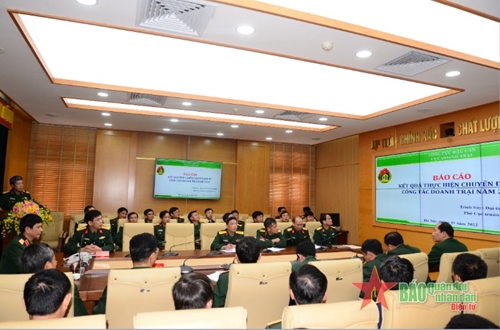During the conference to review the ten-year implementation of the CMC’s Resolution 623-NQ/QUTW, dated October 29, 2012, on military logistics work, delegates were delighted at the impressive results in digital transformation gained by the General Department of Logistics (GDL) over the past ten years.
    |
 |
|
Outcomes in digital transformation in logistics sector reviewed |
Pointing to the room near the main door of GDL headquarters, GDL Deputy Chief of Staff Senior Colonel Vu Quang Mieu shared that before it was only a meeting room. Now it has been upgraded to a multi-function meeting hall used for the operation of digital transformation and the organization of conferences and meetings.
The executive office operates based on the principle of shared infrastructure and centralized database, using technology to decentralize power to agencies and units, exchanging and transferring data via the military’s private data transmission lines.
The office is considered “the brain” of military logistics sector. Its function is to collect and standardize data; analyze, process big data and then issue alerts for the whole activities of the military logistics sector. Therefore, commands at all levels could make prompt and accurate decisions.
Chosen as a model in digital transformation in the whole military, the GDL has coordinated with Command 86, the Military Industry-Telecoms Group (Viettel), the Signal Corps, and the MND’s functional agencies to map out a specific plan for digital transformation of the military logistics work in the 2022-2025 period, with orientation to 2030. Together with defining targets for each phase and eight key tasks to implement the plan in an effective manner, the GDP has selected three departments of Military Medicine, Oil and Petroleum and Barracks as units pioneering in digital transformation.
Up to now, apart from the executive office, the three mentioned departments have worked with functional agencies to design software with practical application.
Particularly, the Department of Barracks has standardized data of the whole logistics sector into a common report form instead of compiling separate reports as before.
The Department of Military Medicine has developed a system called “Electronic health record for military officers” to integrate information about troops’ medical history. Therefore, the department could quickly roll out disease preventive measures and formulate plans for troops’ health protection and care.
The Department of Petroleum has launched software to standardize reports on gasoline and oil import-export-inventory; monitor consumption of affiliated units and results of ensuring gasoline and oil quotas and creating sources for the procurement of gasoline and oil.
Additionally, other agencies and units under the GDL have pushed digital transformation in their professional work. The Department of Political Affairs established a “digital logistics museum” allowing the public to use a smartphone or computer connected to the Internet to take a look at artifacts, documents and photos on display at the Military Logistics Museum. Military Hospital 354 has built a “digital transformation clinic” so that patients can scan QR codes and download applications for online medical registration, and more.
According to Lieutenant General Tran Duy Giang, Director of the General Department of Logistics, in the time to come, the GDL will direct its agencies and units to complete the centralized logistics data warehouse in MND’s general data warehouse; boost digital transformation in Departments of Military Supplies and Transport.
    |
 |
|
Delegates viewing outcomes in digital transformation in logistics sector |
For the 2024-2025 period, the GDL will supplement solutions and tasks and implement digital transformation in its affiliated units and logistics agencies in the whole military, contributing to forming a digital workplace, Lieutenant General Tran Duy Giang added.
By 2030, the GDL sets a goal to finish a synchronous, modern, mobile and safe information technology infrastructure for the logistics sector, meeting the requirements of building a digital workplace and a modern military, among others.
Translated by Quynh Oanh